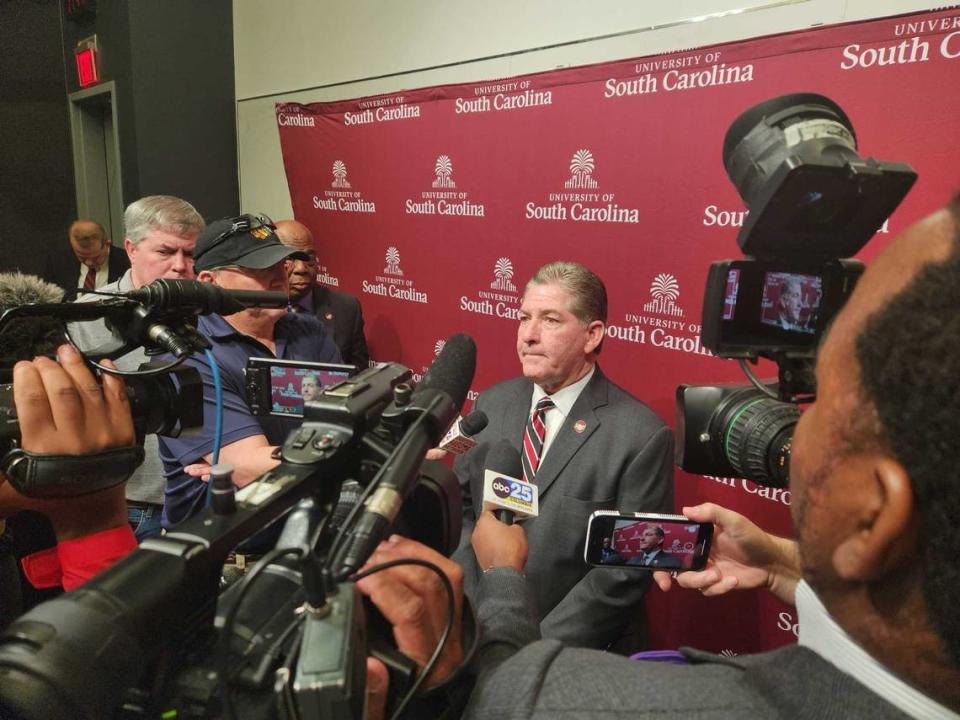The University of South Carolina has taken another step toward major development around Williams-Brice Stadium and renovations to the stadium itself, though details remain limited.
The USC athletic department met with the State Fiscal Accountability Authority on Tuesday in Columbia and received approval to begin soliciting proposals for what can be built on roughly 900 acres of land near the stadium and the Congaree River.
“We’d like to move into the private sector to see what interest there would be,” USC Athletics director Ray Tanner said at Tuesday’s meeting. “We think it would certainly be robust.”
The university wants to create a new, significant stream of revenue for the university through an entertainment district — and help fund stadium renovations that will further modernize the home of Gamecocks football.
Any development will be designed, constructed and funded by private companies and will not be owned, operated or funded by the university, according to meeting-specific documents listed on the authority’s website. USC will be more of a landlord than anything else, looking to make money off a large chunk of un-utilized and/or under-utilized real estate.
The university, however, will be allowed to contract the use of any facility built on the property for dining, student housing, academic space or athletic facilities — or buy any future properties outright for similar purposes, according to documents.
Revenue generated from the private lease agreements will be used for the design and construction of improvements to Williams-Brice Stadium or other university projects, the documents said.
USC’s advancement into the solicitation stage for this project comes 16 months after USC first announced the project. At the time, Tanner said it could take 12 to 15 months for initial plans to form for development of the university-owned land, most of which occupies a floodplain.
Prior to entering the solicitation stage, South Carolina received more than two dozen inquiries and several written responses for the project, university spokesman Jeff Stensland said in April 2023. No timeline for construction is available at this time, but USC has said it does not expect the project to impact any football home games.
The Gamecocks begin the 2024 season at home Aug. 31 versus Old Dominion.
South Carolina has also said that the project will not include moving Williams-Brice Stadium from its current location roughly three miles off campus or acquiring/developing the nearby State Fairgrounds (which had been rumored leading up to the formal announcement of USC’s plans in February 2023).
USC plans to develop the land near the football stadium first before moving onto a second phase around Colonial Life Arena, the home of South Carolina men’s and women’s basketball about three miles away. That continuation of the project would involve developing 17 acres near the arena, where several properties are owned or leased by USC.

A ‘365-day’ experience
University leaders have said these areas could produce $1 billion in revenue over time, and Tanner said USC is hopeful that the project would bring people to the Williams-Brice Stadium area “365 days a year” with a set-up similar to that of The Battery, a popular entertainment district directly next to the Atlanta Braves’ Truist Park, which houses a number of restaurants, bars, shops, a movie theater, hotels and more outside the gates of the stadium.
Such a lucrative cash influx would do wonders for South Carolina as it looks to keep up in the college athletics “arms race” despite having one of the least affluent athletic departments in the SEC. USC ranks 12th out of 15 public SEC schools in annual athletics revenue, according to a USA Today database on college finances.
Potential renovations to Williams-Brice Stadium – which opened in 1934 and has seen various upgrades over the decades – include: an increase in premium suite seating, converting bleachers to individual chairback seating, a new main video board (the current one is over 10 years old), an upgraded locker room, more access to air conditioning and student section enhancements.
South Carolina has spent more than $152 million on football facility upgrades since 2012, with the largest investment being its $50 million operations building that opened ahead of the 2019 season.
These projects are usually funded by capital fund-raising campaigns and donors, USC’s own financial reserves and borrowing money.
But funding stadium improvements through giving alone is difficult, especially as donors are now forced to choose between facilities and name, image and likeness (NIL) opportunities for their contributions. USC’s athletics department also operates with a “debt ceiling” of $200 million that it can borrow against.
The available amount fluctuates as USC repays that debt.
South Carolina’s athletics department currently generates revenue from ticket sales, multimedia rights, major donor giving, the Gamecock Club, the SEC’s revenue distribution and its apparel deal with Under Armour.
Source Agencies


